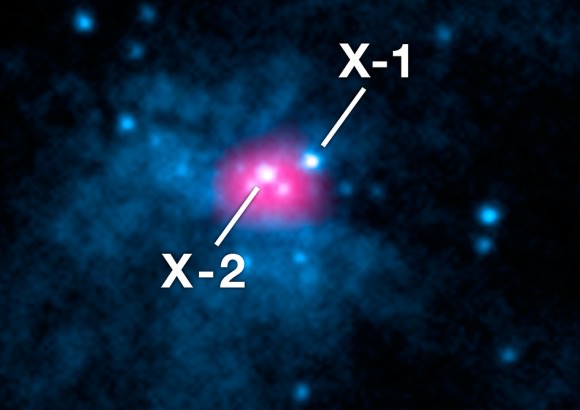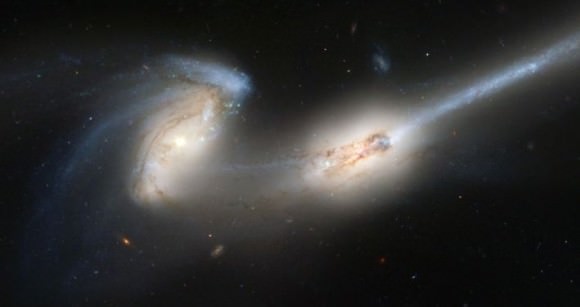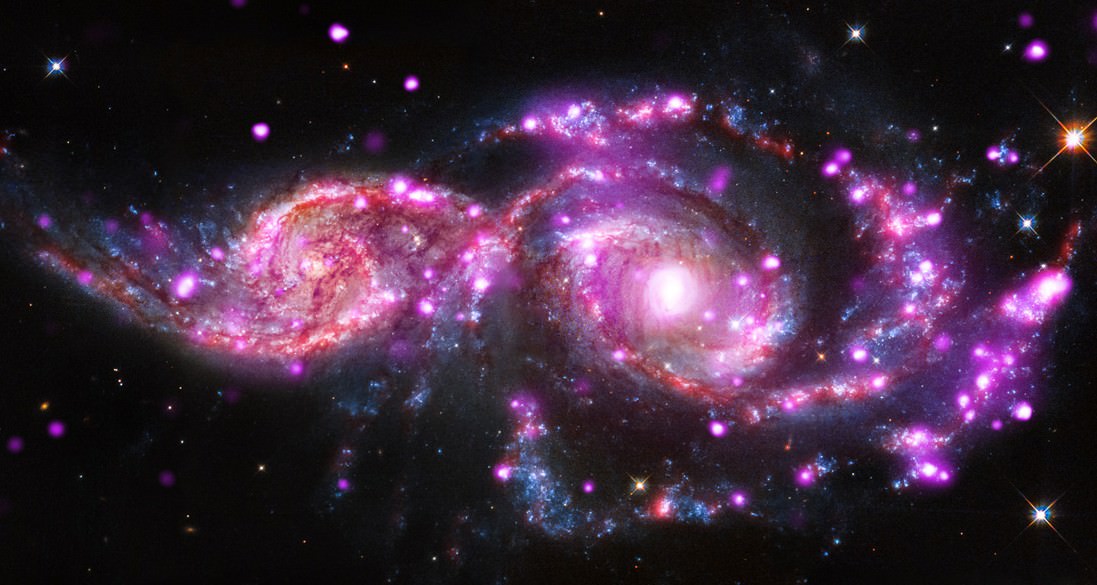At this time of year, festive displays of light are to be expected. This tradition has clearly not been lost on the galaxies NHC 2207 and IC 2163. Just in time for the holidays, these colliding galaxies, which are located within the Canis Major constellation (some 130 million light-years from Earth,) were seen putting on a spectacular lights display for us folks here on Earth!
And while this galaxy has been known to produce a lot of intense light over the years, the image above is especially luminous. A composite using data from the Chandra Observatory and the Hubble and Spitzer Space Telescopes, it shows the combination of visible, x-ray, and infrared light coming from the galactic pair.
In the past fifteen years, NGC 2207 and IC 2163 have hosted three supernova explosions and produced one of the largest collections of super bright X-ray lights in the known universe. These special objects – known as “ultraluminous X-ray sources” (ULXs) – have been found using data from NASA’s Chandra X-ray Observatory.
While the true nature of ULXs is still being debated, it is believed that they are a peculiar type of star X-ray binary. These consist of a star in a tight orbit around either a neutron star or a black hole. The strong gravity of the neutron star or black hole pulls matter from the companion star, and as this matter falls toward the neutron star or black hole, it is heated to millions of degrees and generates X-rays.

Data obtained from Chandra has determined that – much like the Milky Way Galaxy – NGC 2207 and IC 2163 are sprinkled with many star X-ray binaries. In the new Chandra image, this x-ray data is shown in pink, which shows the sheer prevalence of x-ray sources within both galaxies.
Meanwhile, optical light data from the Hubble Space Telescope is rendered in red, green, and blue (also appearing as blue, white, orange, and brown due to color combinations,) and infrared data from the Spitzer Space Telescope is shown in red.
The Chandra observatory spent far more time observing these galaxies than any previous ULX study, roughly five times as much. As a result, the study team – which consisted of researchers from Harvard University, MIT, and Sam Houston State University – were able to confirm the existence of 28 ULXs between NGC 2207 and IC 2163, seven of which had never before been seen.
In addition, the Chandra data allowed the team of scientists to observe the correlation between X-ray sources in different regions of the galaxy and the rate at which stars are forming in those same regions.

As the new Chandra image shows, the spiral arms of the galaxies – where large amounts of star formation is known to be occurring – show the heaviest concentrations of ULXs, optical light, and infrared. This correlation also suggests that the companion star in the star X-ray binaries is young and massive.
This in turn presents another possibility which has to do with star formation during galactic mergers. When galaxies come together, they produce shock waves that cause clouds of gas within them to collapse, leading to periods of intense star formation and the creation of star clusters.
The fact that the ULXs and the companion stars are young (the researchers estimate that they are only 10 million years old) would seem to confirm that they are the result of NGC 2207 and IC 2163 coming together. This seem a likely explanation since the merger between these two galaxies is still in its infancy, which is attested to by the fact that the galaxies are still separate.
They are expected to collide soon, a process which will make them look more like the Mice Galaxies (pictured above). In about one billion years time, they are expected to finish the process, forming a spiral galaxy that would no doubt resemble our own.
A paper describing the study was recently published on online with The Astrophysical Journal.
Further Reading: NASA/JPL, Chandra, arXiv Astrophysics


” this x-ray data is shown in pink, which shows the SHEER PREVALENCE of x-ray sources within both galaxies.”
The resulting picture is stunning; but what an INHOSPITABLE place for LIFE!
Its nice to know that it is expected to calm down once the merger is complete “in about a billion years”.